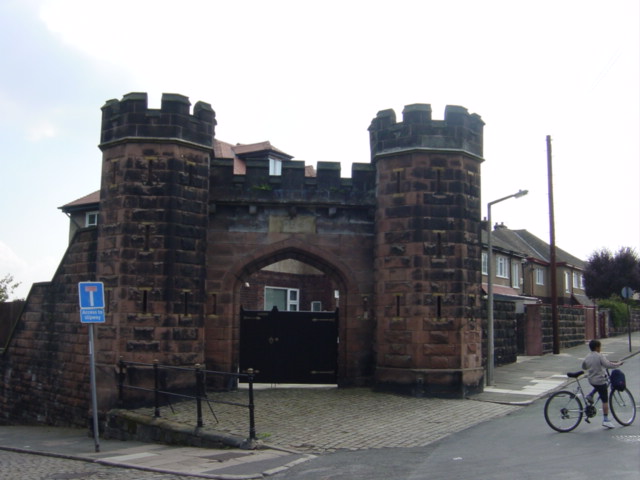File:Liscard Battery Gateway-by-Sue-Adair.jpg
Liscard_Battery_Gateway-by-Sue-Adair.jpg (640 × 480 pixels, file size: 61 KB, MIME type: image/jpeg)
Captions
Captions
Summary[edit]
| DescriptionLiscard Battery Gateway-by-Sue-Adair.jpg |
Liscard Battery Gateway. At the junction of Magazine Brow and Fort Street is the gateway to the former Liscard Battery (also known as the Magazines Fort). Constructed in 1858 of local dark red sandstone, it housed a small garrison colony of the 55th Royal Artillery. Ships carrying gunpowder would deposit their stock before landing in either Liverpool or Birkenhead. They retrieved their powder before sailing. In the 1750s the Corporation of Liverpool decided to move the Powder Magazines, used to store explosive and shot from ships in port, from their site in Clarence Street and find a more isolated site for them on the Cheshire side of the River Mersey. Accordingly, a suitable plot was purchased on the south bank of the Mersey at Wallasey and the new magazine constructed. They were renovated and enlarged in 1838-39, and were still in use until 1851, when it was decided that in future explosives would be stored in hulks further up the river at the Bight of Sloyne. The move was probably prompted by safety concerns, the land around the Magazines having become much more built up. In 1858 a battery was built on the site, and the imposing gateway with its crenulated towers, survives to this day as does the perimeter wall which now encircles several houses. Facing the south wall of the battery, on the other side of the road (Magazine Brow) are several cottages, perhaps dating from the 17th Century. These were probably first inhabited by fishermen, but it is thought that they were later occupied by offices from the battery. The Magazines were often referred to as Liscard Magazines and the fort as Liscard Battery, but the name Liscard later became attached to an area about a mile away where Wallasey's main shopping area is situated. A quaint circular dwelling may be seen about fifty yards from the fort's gateway, this being known as the Round House. Now forming part of a private residence, this was once occupied by the battery's watchman. Further along Magazine Brow are situated two public houses, the Pilot Boat and The Magazines, the latter having been built in 1759 and once used by sailors who were having their outward bound ships reloaded with munitions at the Liscard Magazines. |
| Date | |
| Source |
From geograph.org.uk [Source=From [1] |
| Author | Sue Adair |
| Permission (Reusing this file) |
Creative Commons Attribution Share-alike license 2.0 |
| Attribution (required by the license) InfoField | Sue Adair / Liscard Battery Gateway / |
InfoField | Sue Adair / Liscard Battery Gateway |
| Camera location | 53° 25′ 55.2″ N, 3° 02′ 02.33″ W | View this and other nearby images on: OpenStreetMap |
|---|
Licensing[edit]

|
This image was taken from the Geograph project collection. See this photograph's page on the Geograph website for the photographer's contact details. The copyright on this image is owned by Sue Adair and is licensed for reuse under the Creative Commons Attribution-ShareAlike 2.0 license.
|
- You are free:
- to share – to copy, distribute and transmit the work
- to remix – to adapt the work
- Under the following conditions:
- attribution – You must give appropriate credit, provide a link to the license, and indicate if changes were made. You may do so in any reasonable manner, but not in any way that suggests the licensor endorses you or your use.
- share alike – If you remix, transform, or build upon the material, you must distribute your contributions under the same or compatible license as the original.
File history
Click on a date/time to view the file as it appeared at that time.
| Date/Time | Thumbnail | Dimensions | User | Comment | |
|---|---|---|---|---|---|
| current | 20:35, 30 October 2009 |  | 640 × 480 (61 KB) | Benkid77 (talk | contribs) | == Summary == {{Information |Description=Liscard Battery Gateway. At the junction of Magazine Brow and Fort Street is the gateway to the former Liscard Battery (also known as the Magazines Fort). Constructed in 1858 of local dark red sandstone, it housed |
You cannot overwrite this file.
File usage on Commons
There are no pages that use this file.
Metadata
This file contains additional information such as Exif metadata which may have been added by the digital camera, scanner, or software program used to create or digitize it. If the file has been modified from its original state, some details such as the timestamp may not fully reflect those of the original file. The timestamp is only as accurate as the clock in the camera, and it may be completely wrong.
| Camera manufacturer | SONY |
|---|---|
| Camera model | CYBERSHOT |
| Exposure time | 1/250 sec (0.004) |
| F-number | f/5.6 |
| ISO speed rating | 100 |
| Date and time of data generation | 12:01, 17 August 2005 |
| Lens focal length | 8 mm |
| Orientation | Normal |
| Horizontal resolution | 72 dpi |
| Vertical resolution | 72 dpi |
| File change date and time | 12:01, 17 August 2005 |
| Y and C positioning | Co-sited |
| Exposure Program | Normal program |
| Exif version | 2.1 |
| Date and time of digitizing | 12:01, 17 August 2005 |
| Image compression mode | 2 |
| APEX exposure bias | 0 |
| Maximum land aperture | 3 APEX (f/2.83) |
| Metering mode | Center weighted average |
| Light source | Unknown |
| Flash | Flash did not fire |
| Color space | sRGB |
